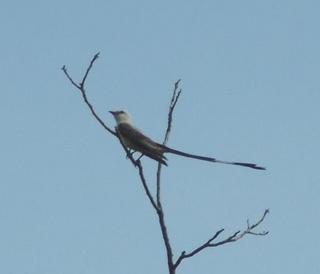A Relative Quiet
Monday, September 26th, 2005September 26, 2005
To describe the woods, fields and yards of our neighborhood during the past week is to speak more of what’s not there than of what is. The Fall season has crept in quietly here – though quiet in a relative sense. Carolina Wrens still sing and chatter and fuss and burble, and it’s at this time of year that I always notice most their amazing vocal variety. Carolina Chickadees and Tufted Titmice still move through the trees in small gossiping bands. The “pik-a-tuk” of a Summer Tanager, the throaty song of a Yellow-throated Vireo, and the “whreeep!” of a Great-crested Flycatcher can still be heard from time to time, though not nearly as often as a few weeks ago, and there’s at least one Eastern Wood Peewee lingering in the trees down the street from us, singing broken pieces of its summery song from time to time.
The most noticeable singers this past week have been Phoebes, which begin their wheezy, brisk songs at first light and continue most of the day. This morning I heard three singing at the same time, just along one stretch of road, and came to another and another and another as I walked through the neighborhood. Wind rustles through the trees. Dry leaves and pine needles shower down in a soft clatter. Acorns plop or thunk. The shrill, thin noise of insect legs and wings and hearts is constant in the background, a few remaining Chimney Swifts twitter in small groups overhead, Bluebirds murmur from perches in the tops of trees, and noisy gangs of Blue Jays and Crows roam from yard to yard.
Nevertheless, it feels quiet, and is, compared to the musical fullness of Summer. In the Old Field, now dry and withered from a long time without rain, but flooded with the dusty yellow and dull green of Goldenrod and Ragweed, the bold, colorful songs of Indigo Bunting, Blue Grosbeak and Yellow-breasted Chat are gone. Even the sharp “plink” of the female Blue Grosbeak, which stayed until very recently, seems to be gone now – though in its place, I’ve heard the mew of a Catbird, the percussive song of a White-eyed Vireo, and the harsh calls of Brown Thrashers and Mockingbirds. The demanding scream of the juvenile Red-tailed hawk that used to sit for long hours on a utility pole over the Old Field is rarely heard now, though on the other hand, two Red-shouldered Hawks have been soaring very high in deep marbled blue and white September skies and calling frequently.
In the woods, the Acadian Flycatcher’s dry “tse-wheet!”, the Yellow-billed Cuckoo’s exotic “Cawp-cawp-caalwp,” the Mississippi Kite’s high, descending “pe-teeeew,” the repeated refrain of the Red-eyed Vireo, and the “chip-burrr” of a Scarlet Tanager’s call remain only as memories. And I guess that’s what seems most alive in this relatively quiet time – while I watch and wait for unusual warblers and other migrants that might pass through, and for the first arrivals of our Winter residents – there are good, sun-ripened memories of the Summer past.
